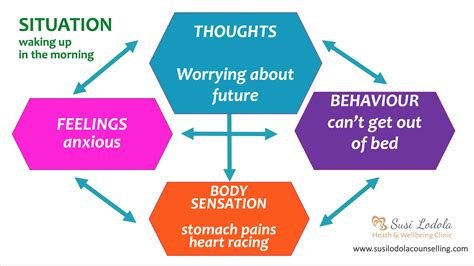Negative Thoughts
Table of Contents
Negative thoughts are persistent and often automatic thoughts that can adversely affect one’s emotional and mental well-being. These thoughts frequently stem from a variety of origins, including past experiences, societal influences, and inherent cognitive tendencies. For many individuals, the development of negative thought patterns can be attributed to formative life events that shape how they perceive themselves and the world around them. As these thoughts become ingrained, they can lead to further psychological distress, such as anxiety and depression.
Common negative thought patterns, also known as cognitive distortions, encompass various forms of irrational thinking. For instance, “all-or-nothing” thinking reduces complex situations to binary outcomes, disregarding the grey areas, which can lead to feelings of failure or inadequacy. Another common cognitive distortion is overgeneralization, where one negative experience is viewed as a universal truth, further perpetuating a negative self-image. Mind reading, where individuals assume they know what others are thinking, can also intensify feelings of isolation and misunderstanding.
The impact of these negative thought patterns extends beyond mere feelings; they can significantly influence decision-making and overall behavior. For example, someone who believes they are incapable may avoid challenges that could foster personal growth, thereby reinforcing their negative beliefs. Recognizing these patterns is crucial as it is the first step towards managing them effectively. Becoming aware of these thoughts empowers individuals to challenge and reframe them, ultimately leading to healthier cognitive patterns. This awareness can be the foundation upon which individuals build resilience against anxiety and depression, fostering a more positive outlook towards life.
Identifying Negative Thought Patterns

Recognizing negative thought patterns is a crucial step in managing them effectively. Individuals often encounter thoughts that can be categorized as either rational or irrational. Understanding the distinction between these types of thoughts can empower individuals to challenge the negative beliefs that may impact their emotional well-being. One effective method for identifying these patterns is through journaling. By regularly documenting thoughts and feelings, individuals can create a tangible record of their mental processes, allowing them to notice recurring themes or triggers that contribute to negative thinking.
Mindfulness practices also play a significant role in recognizing negative thought patterns. Engaging in mindfulness involves paying attention to one’s thoughts and feelings without judgment. Techniques such as meditation or deep breathing exercises can help individuals observe their thoughts as they arise, creating space for reflection rather than immediate reaction. This practice encourages a level of awareness that is essential for distinguishing between constructive self-evaluation and harmful self-criticism.
Self-reflection exercises further aid in cultivating an understanding of negative thought processes. Setting aside time to contemplate specific situations can help individuals analyze their thoughts critically. Questions such as “What evidence do I have that supports this thought?” or “Is there another perspective I could consider?” prompt individuals to assess the validity of their assumptions. These exercises can be instrumental in revealing irrational thoughts that often lead to feelings of anxiety or depression.
In summary, identifying negative thought patterns through journaling, mindfulness practices, and self-reflection allows individuals to cultivate a greater awareness of their mental processes. By differentiating between rational and irrational thoughts, individuals can begin to challenge these patterns, leading to more adaptive thinking and emotional resilience.
The Role of Cognitive Behavioral Therapy (CBT)
Cognitive Behavioral Therapy (CBT) is a widely recognized and effective approach to addressing negative thought patterns, which can significantly impact an individual’s mental health and overall quality of life. The fundamental principle of CBT revolves around the cognitive model, which asserts that our thoughts, feelings, and behaviors are interconnected. By targeting negative beliefs, CBT empowers individuals to recognize and reframe these detrimental thoughts into more positive and constructive ones.
One of the first steps in CBT is identifying specific negative thought patterns that contribute to feelings of anxiety, depression, or low self-esteem. Common distorted thoughts include all-or-nothing thinking, overgeneralization, and catastrophizing. By becoming aware of these cognitive distortions, individuals can begin to challenge and deconstruct them. This process is crucial for developing healthier thought processes that promote emotional wellness.
CBT also emphasizes the importance of reframing negative thoughts. This process involves critically assessing the evidence for these thoughts and considering alternative interpretations. For instance, instead of thinking, “I always fail at everything,” a person can reframe this thought to recognize instances of success and progress, thus fostering a more balanced perspective. This shift not only reduces cognitive distortions but also encourages a proactive approach to life’s challenges.
Moreover, CBT can be seamlessly integrated into daily routines through various techniques. Keeping a thought journal, practicing mindfulness, and engaging in problem-solving exercises can reinforce the skills learned in therapy. Furthermore, individuals can cultivate positive coping strategies by engaging in activities that promote well-being, such as physical exercise, social interaction, and pursuing hobbies. Ultimately, by applying CBT principles in everyday life, individuals can effectively manage negative thought patterns, leading to improved emotional health.
Challenging Negative Thoughts

Once negative thoughts have been recognized, it becomes essential to challenge their validity. One effective approach is to question the accuracy of these detrimental thoughts. For instance, consider asking yourself whether the thought is based on facts or assumptions. Is there substantial evidence supporting this belief? Often, negative thoughts stem from cognitive distortions, such as overgeneralization or catastrophizing. By identifying these distortions, individuals can create a clearer picture of their reality.
Another practical strategy is the use of thought-stopping techniques. This involves mentally interrupting the flow of negative thoughts. When a negative thought arises, say “stop!” either aloud or internally. This interruption can provide a brief moment to gather your thoughts and prevent the negativity from escalating. Following the interruption, one can then redirect focus to more positive or neutral thoughts. This reallocation of mental energy serves to diminish the hold that negative thinking can have on our emotional state.
Cognitive restructuring is also a noteworthy technique for managing negative thoughts. It encourages individuals to replace irrational beliefs with more rational ones. For example, transform a thought like “I always fail” into “I have experienced failures, but I have also succeeded in many areas.” This shift fosters healthier perspectives, allowing individuals to break free from cyclical negative thinking. Additionally, keeping a thought journal can be beneficial, where one logs negative thoughts and replaces them with balanced affirmations. Not only does this practice provide insight into one’s thought patterns, but it actively engages the mind in cognitive reframing.
Implementing these strategies diligently can lead to a significant reduction in the frequency and intensity of negative thoughts. Change takes time and patience, yet challenging negative thoughts is a pivotal step towards achieving mental well-being.
Developing Positive Thinking Habits
Creating an environment conducive to positive thinking is essential for combating negative thought patterns. One effective method for nurturing a more optimistic mindset is gratitude journaling. This practice involves dedicating time each day to jot down things for which you are thankful, fostering a sense of appreciation and enhancing overall mental well-being. By regularly reflecting on positive aspects of life, individuals can shift their focus away from negativity and engage more fully with positive experiences.
Another powerful tool for developing positive thinking habits is the use of positive affirmations. These are simple, powerful statements that reinforce one’s strengths and capabilities. Repeating affirmations daily allows individuals to challenge their negative thoughts directly. By replacing detrimental self-talk with encouraging phrases, one can significantly alter their perception of themselves and their circumstances. Over time, this consistency can lead to a profound transformation in outlook, reducing the prevalence of negative thinking.
Visualization techniques also serve as an effective strategy for empowering positive thought patterns. This involves visualizing oneself achieving goals and maintaining a positive state of mind. By creating vivid, mental images of success and happiness, individuals are more likely to cultivate a positive outlook. This practice not only inspires motivation but also enhances self-belief, further diminishing the influence of negative thoughts. Coupling visualization with routine can create a powerful reinforcement system that effectively counters negativity.
In conjunction with these practices, maintaining a supportive social circle plays a crucial role in nurturing positivity. Engaging in meaningful conversations and sharing experiences allows for mutual support. Embracing these proactive measures—gratitude journaling, positive affirmations, and visualization—can collectively help reduce the frequency and impact of negative thoughts. By consciously cultivating these habits, individuals pave the way for a more positive future, substantially transforming their mental landscape.
The Impact of Lifestyle Changes on Negative Thoughts

Negative thought patterns can significantly impact an individual’s mental well-being, leading to feelings of anxiety, depression, and stress. However, adopting positive lifestyle changes can serve as a powerful means to counter these detrimental effects. One of the most effective strategies to manage negative thoughts is through physical exercise. Engaging in regular physical activity has been shown to release endorphins, which are natural mood lifters. Even simple activities such as walking or cycling can reduce symptoms of anxiety and depression, promoting a more positive mindset.
Healthy eating habits also play a pivotal role in mental clarity and emotional stability. Studies suggest that a diet rich in fruits, vegetables, whole grains, and lean proteins can enhance brain function and contribute to improved mood regulation. Nutritional components, such as omega-3 fatty acids found in fish, have been linked to decreased levels of depression and anxiety. By making conscious food choices, individuals can foster a more supportive environment for mental health and effectively manage negative thought patterns.
Adequate sleep is another critical factor that cannot be overlooked when addressing negative thoughts. Quality sleep is essential for cognitive function and emotional resilience. Insufficient sleep can lead to heightened irritability and exacerbate negative thinking. Therefore, establishing a regular sleep schedule and creating a calming bedtime routine can help improve sleep quality. This, in turn, can facilitate a more positive outlook on life.
Integrating these lifestyle changes does not require a complete overhaul of daily routines; instead, small adjustments can yield significant results over time. By incorporating physical exercise, maintaining a balanced diet, and prioritizing sleep, individuals can harness the power of healthy habits to combat negative thought patterns effectively, leading to enhanced mental resilience and overall well-being.
Seeking Professional Help
When confronted with persistent negative thought patterns, recognizing the need for professional assistance is a critical step towards improved mental health. Individuals may find themselves overwhelmed by feelings of helplessness, anxiety, or depression due to these pervasive thoughts. In such circumstances, reaching out to mental health professionals, including therapists and counselors, can be a beneficial move. Trained mental health practitioners offer valuable insights and coping strategies tailored to individual needs, ultimately assisting in re-framing adverse thoughts.
It is essential to identify the right time to seek professional help. Signs that suggest it may be time to consult a mental health expert include experiencing difficulty in managing daily responsibilities, feelings of isolation, or an inability to focus due to intrusive thoughts. If the negative thoughts lead to changes in sleeping or eating patterns, withdrawal from previously enjoyed activities, or instances of self-harm, seeking help should be considered as an urgent priority.
Finding a suitable therapist can be facilitated by researching licensed professionals within one’s locality, seeking referrals from healthcare providers, or using online directories. Many individuals benefit from a preliminary consultation to determine the therapist’s approach and methodology, ensuring that it aligns with personal preferences. Additionally, exploring community resources such as support groups allows individuals to connect with others facing similar challenges, fostering a sense of belonging and understanding.
Support groups can serve as vital platforms for sharing experiences and coping strategies, contributing significantly to emotional well-being. These gatherings offer an opportunity for individuals to learn from one another and develop supportive relationships. In essence, by recognizing the signs that suggest a need for professional support and actively seeking help, people can effectively manage negative thought patterns and improve their overall mental health.
Maintaining Progress and Staying Vigilant
After achieving initial success in managing negative thought patterns, the critical task of maintaining this progress becomes paramount. It is not uncommon for individuals to experience a relapse into negative thinking, especially during stressful periods or life transitions. To prevent this from occurring, it is essential to adopt strategies that promote sustained self-awareness and resilience.
One effective approach is to engage in regular self-reflection. This can involve journaling, meditative practices, or simply taking time to assess one’s thoughts and emotions. By monitoring changes in mindset, individuals can identify early indicators of negative thought patterns re-emerging. Recognizing these signs promptly allows for proactive measures to be implemented before they escalate.
Incorporating self-care practices into daily routines is another crucial aspect of maintaining progress. Engaging in physical activities, pursuing hobbies, and ensuring adequate rest can significantly affect mental well-being. Positive habits foster resilience against negative thinking and create a buffer during challenging times. Therefore, prioritizing self-care not only nurtures the mind and body but also strengthens one’s ability to combat negative thought patterns.
Additionally, a robust support system can provide vital encouragement and accountability. This support can come in various forms, such as friends, family, or mental health professionals. Regular discussions about feelings and experiences can help individuals stay grounded and motivated on their journey toward sustaining positive change. Through shared experiences, one can draw upon the strengths and insights of others, further enhancing their ability to navigate potential setbacks.
In conclusion, maintaining progress in managing negative thought patterns requires vigilance and a commitment to self-awareness, self-care, and support. By integrating these strategies into daily life, individuals can cultivate a more positive mindset and ultimately foster long-lasting changes in their mental health.
Conclusion: Embracing a Positive Mindset
Recognizing and managing negative thought patterns is crucial for achieving and maintaining a healthy mental state. Throughout this blog post, we have explored various techniques that are effective in addressing these detrimental thought processes. From cognitive restructuring to mindfulness practices, each method serves as a stepping stone toward fostering a more positive mindset.
By learning to identify negative thoughts and their triggers, individuals can begin to challenge the validity of these thoughts. Techniques such as reframing negative statements into more constructive ones empower individuals to gain control over their thoughts, thus diminishing the power these patterns hold. Additionally, techniques such as mindfulness and meditation facilitate awareness of one’s thoughts and emotions, enabling a more detached view that encourages personal growth.
Furthermore, seeking support from friends, family, or mental health professionals can significantly enhance one’s ability to manage negativity. Sharing experiences and emotions often alleviates the burden and reinforces the understanding that one is not alone in their struggles. Implementing these strategies creates a foundation for developing resilience, which is essential when faced with life’s challenges.
It is important to emphasize that embracing a positive mindset is not merely a one-time effort; it is an ongoing journey. Each step taken toward overcoming negative thought patterns is a victory worth celebrating. As people continuously practice these techniques, they equip themselves with the tools needed for a more fulfilling and balanced life. Ultimately, the shift toward positivity not only transforms individual perspectives but also enhances overall well-being.
In conclusion, by acknowledging and addressing negative thought patterns, individuals pave the way for a healthier, more optimistic approach to life. Engaging with these techniques and remaining committed to personal growth will foster a profound change in how one interacts with their thoughts and emotions.



[…] Professional help can come in various forms, including therapy and medication, tailored to fit individual needs. Therapeutic options such as cognitive-behavioral therapy (CBT) and interpersonal therapy (IPT) have proven effective for many individuals dealing with depression. These therapies provide a structured environment to explore feelings, develop coping strategies, and modify negative thought patterns. Engaging with a licensed mental health professional can guide individuals on a path to recovery, equipping them with tools and techniques to better manage their emotions. […]
[…] In summary, the impact of affirmations on mental health is profound, offering individuals the tools to combat anxiety, boost self-esteem, and build resilience. By consciously integrating affirmations into their lives, many have experienced significant transformations, highlighting the potential of positive thinking in enhancing overall mental well-being. […]